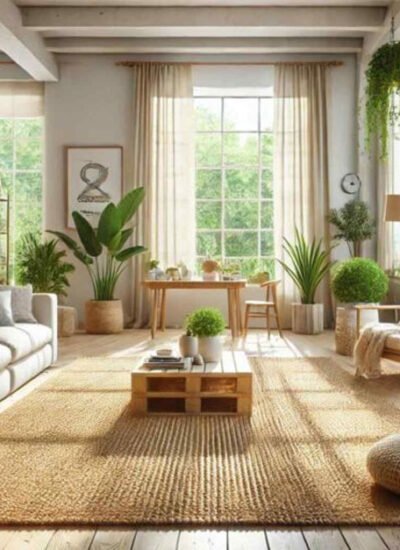 It’s safe to say that sustainability is no longer just a trend in today’s home design world, because it’s now a widespread lifestyle choice that countless people all over the world are fully embracing.
It’s safe to say that sustainability is no longer just a trend in today’s home design world, because it’s now a widespread lifestyle choice that countless people all over the world are fully embracing.
Homeowners are now seeking out better ways to align their living spaces with their long held, eco-friendly values—and one overlooked design element that can make a big difference in a household is large area rugs.
Not only do large rugs visually anchor rooms from an aesthetic standpoint, but they can also support healthier, greener homes when chosen wisely.
We recently got in touch with Rug Source’s experts in large area rugs to ask them a few questions about how everyday families can embrace sustainability with their flooring décor, and what we learned is something that all households are going to want to know.
So, check out the below sections to learn more about the following:
- Why eco-friendly large rugs matter
- Natural fiber options to keep in mind during your rug shopping
- Recycled and upcycled large area rugs
- Non-toxic rug dyes and finishes
- Green certifications to be on the lookout for
Why Eco-Friendly Large Rugs Matter
What a lot of homeowners don’t realize is that a huge portion of today’s conventional area rugs are made from synthetic materials like polyester, nylon and polypropylene.
And although these materials are durable, they come from non-renewable resources like petroleum—and they often contribute to volatile organic compounds (VOCs) that can lead to decreases in a home’s overall indoor air quality (IAQ).
On the other hand, today’s eco-friendly large rugs are specifically designed with natural materials and sustainable production methods. Choosing eco-friendly rugs helps homeowners reduce their overall carbon footprints, while also developing healthier homes for families!
Natural Rug Fiber Options To Keep In Mind During Your Shopping
One way to make sure that you’re prioritizing eco-friendly large rugs during your shopping sessions is by choosing rugs made from natural fibers.
These materials are biodegradable, renewable, and totally free of any harmful chemicals—unlike their synthetic alternatives. Some of the most popular natural rug fibers to consider include:
- Wool:Wool rugs are known for being flame-resistant, long-lasting and very insulating. Wool rugs also provide an unparalleled underfoot softness.
- Jute:Jute rugs offer a rustic aesthetic that a lot of homeowners love, and they’re also known for their warmth and unique texture. Jute is also a very sustainable crop.
- Sisal:Sisal rugs are both resilient and durable, so they’re good options in high-traffic areas.
- Cotton:Cotton rugs are versatile, breathable and biodegradable. There are countless options available in various styles, including flatweave designs that can be both floor and wall art.
Recycled & Upcycled Rugs
Another huge trend in today’s rug industry is recycled and upcycled rug materials.
This means that some manufacturers are creating large area rugs out of repurposed textiles and even recycled plastic bottles. And what’s wild is that these rugs are surprisingly durable, soft and stylish.
Vintage textiles and patchwork rugs are also growing in popularity in 2025 due to their ability to reduce textile waste and give a second life to existing materials.
Non-Toxic Rug Dyes & Finishes
It’s also important to note that dyes and treatments can make a huge difference on a rug’s overall eco-friendliness, even when it’s made from natural fibers.
This is why green households should look for area rugs that are made from low-impact or natural dyes.
This is another growing trend in the rug industry, because countless eco-conscious homeowners are avoiding stain guards, chemical flame retardants and other toxic finishes.
Green Area Rug Certifications To Be On The Lookout For
There are many certifications that rug shoppers can keep in mind to give themselves peace of mind in knowing that they’re in fact looking at sustainable large area rugs.
Some useful labels include:
- GoodWeave: GoodWeave certificationsguarantee that no forced or child labor was used during the production of an area rug, and that sustainable manufacturing practices were promoted.
- Global Organic Textile Standard (GOTS): The Global Organic Textile Standardcertification guarantees that an area rug’s fibers were grown organically and processed with strict social and environmental criteria.
- OEKO-TEX Standard 100:This certification tests for all sorts of harmful substances, which guarantees that a rug is 100% safe for indoor environments.
Styling Your Home With Eco-Friendly Large Area Rugs
What’s great about today’s eco-friendly large area rugs is that they’re much more than just a sustainable option, because they’re also very versatile from an interior design standpoint as well.
Large, neutral wool rugs help ground open-concept floorplans, and bold, recycled rugs often add a splash of color to patios and family rooms. Sisal and jute rugs also provide that natural, texturized aesthetic that can be great for adding character in bathrooms, foyers and hallways.
By choosing eco-friendly rugs, you won’t have to worry about sacrificing your home’s style—because you’ll actually be enhancing it with a meaningful aesthetic story that you can share with your family and friends!
More Rug Shoppers Are Making Conscious Purchasing Choices In 2025
It’s crucial for people to remember how every purchase they make slowly but surely shapes the world around us. By prioritizing eco-friendly large rugs, your small step can be one step closer to a much bigger impact.
Not only do these rugs support the environment as a whole, but they also improve a home’s IAQ and develop a more authentic home décor ambience.
So, by choosing eco-friendly large rugs, homeowners are also making investments in a sustainable future, while also creating comfortable living spaces that align with their household’s green values!





Leave a Reply